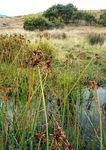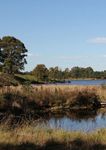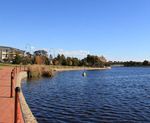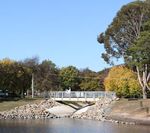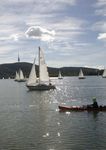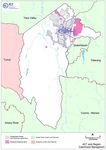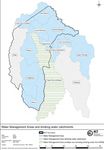ACT Water Strategy 2014-44 - Striking the Balance AUGUST 2014
←
→
Page content transcription
If your browser does not render page correctly, please read the page content below
Minister’s foreword
The ACT Water Strategy 2014–44: Striking the Balance (ACT Water Strategy) will
guide management of the Territory’s water supply, management and catchment
practices over the next 30 years.
The ACT Water Strategy builds on the achievements of the original ACT Water
Strategy, Think water, act water that successfully navigated the ACT through the
serious drought that ended in 2009 and the 2003 bushfire recovery to greater
water supply security. Long term water security and efficient use of water is
central to a sustainable future for the Territory.
Implementation of the ACT Water Strategy will deliver continued water security,
improved water quality and catchment health and a water smart community that embraces its waterways and
makes decisions with water in mind.
The ACT Water Strategy will guide:
• improved integrated catchment management in the ACT and region
• long term security of water supplies to meet the needs of a growing population and the environment
• strategic investment in catchment management and water security
• integrated water cycle management in the planning and design of urban environments
• provision of safe and clean water for the ACT
• strong community involvement in water resource management.
The active engagement of the community in assisting with components of the strategy in key areas such as
catchment management and water use efficiency will be a critical factor to its long-term success.
The ACT Water Strategy will provide a basis for ensuring the ACT Government can continue to support current
and future growth, achieve desired environmental outcomes, and be responsive to climate change.
Simon Corbell MLA
Minister for the Environment
August 2014
environment.act.gov.au iISBN 978-1-921117-33-6 © Australian Capital Territory, Canberra 2014 This work is copyright. Apart from any use as permitted under the Copyright Act 1968, no part may be reproduced by any process without written permission from: Director-General, Environment and Planning Directorate, ACT Government, GPO Box 158, Canberra ACT 2601. Telephone: 02 6207 1923 Website: www.environment.act.gov.au Printed on recycled paper ACCESSIBILITY The ACT Government is committed to making its information, services, events and venues as accessible as possible. If you have difficulty reading a standard printed document and would like to receive this publication in an alternative format, such as large print, please phone Canberra Connect on 13 22 81 or email the Environment and Planning Directorate at epd_communications@act.gov.au If English is not your first language and you require a translating and interpreting service, please phone 13 14 50. If you are deaf, or have a speech or hearing impairment, and need the teletypewriter service, please phone 13 36 77 and ask for Canberra Connect on 13 22 81. For speak and listen users, please phone 1300 555 727 and ask for Canberra Connect on 13 22 81. For more information on these services visit http://www.relayservice.com.au ii ACT Water Strategy 2014–44: Striking the Balance
Contents
Minister’s foreword i
Figure list iv
Table list iv
Abbreviations iv
Executive summary 2
1. Background 7
Purpose of the ACT Water Strategy 7
2. Policy drivers that inform the ACT Water Strategy 9
2.1 National water reform 9
2.2 Regional context 11
2.3 Water policy framework in the ACT 11
3. Opportunities and challenges: our current and future water environment 17
3.1 Water resources in the ACT 17
3.2 Current and future demand for water 19
3.3 Water for recreation 22
3.4 Climate change – impacts and adaptation 23
4. Responding to long term water management challenges – the way forward 27
OUTCOME 1: Healthy catchments and waterbodies 27
OUTCOME 2: A sustainable water supply used efficiently 34
OUTCOME 3: A community that values and enjoys clean, healthy catchments and waterways 38
5. Monitoring, evaluation and review 43
5.1 How will the ACT Water Strategy be monitored? 43
5.2 Targets and indicators 43
5.3 Review 45
6. Implementation 47
6.1 Implementation mechanisms 47
7. Bibliography 49
environment.act.gov.au iiiFigure list
Figure 1: The ACT sits within the MDB 3
Figure 2: Conceptual diagram illustrating the role of ICM in balancing environmental
concerns, economic issues and social needs and values 12
Figure 3: ICM involves managing land and water resources across borders 13
Figure 4: Key elements of the ACT and Queanbeyan’s water supply system 18
Figure 5: Water consumption by sector in the ACT 19
Figure 6: W
ater consumption in the ACT in comparison to other areas of the MDB 20
Figure 7: Net water consumption (ABS and ACTEW) and population growth 2001-2013 20
Figure 9: Autumn and winter rainfall has declined in south east Australia since the mid 1990s 24
Figure 10: Water management areas and drinking water catchments 28
Figure 11: Natural Resource Management based Community Groups in the ACT and Region 41
Table list
Table 1: The ACT Water Strategy Approach 5
Table 2: Continuity between TWAW (2004) and the ACT Water Strategy (2014–44) 8
Table 3: Key national reports examining urban water reform 10
Table 4: Future ACT region population projections and water needs 21
Table 5: Examples of previous initiatives related to water and climate change adaptation 25
Abbreviations
ACT Australian Capital Territory
ACTEW ACTEW Corporation Limited
COAG Council of Australian Governments
DGWG Directors-General Water Group
GL gigalitre (1 billion litres)
GL/y gigalitres per year
ICRC Independent Competition and Regulatory Commission
kL kilolitres (1 thousand litres)
MDB Murray-Darling Basin
MDBA Murray-Darling Basin Authority
ML megalitres (1 million litres)
NRM Natural Resource Management
NSW New South Wales
NWI National Water Initiative
SDL Sustainable Diversion Limit
TWAW Think Water, Act Water (previous Water Strategy)
WSUD Water sensitive urban design
iv ACT Water Strategy 2014–44: Striking the BalanceExecutive summary
The ACT Water Strategy 2014–44: Striking the Balance (ACT Water Strategy) has the following vision for water
management in the ACT over the next 30 years.
A community working together, managing water wisely to support a vibrant, sustainable and
thriving region.
The ACT Water Strategy is focussed on achieving three outcomes:
Outcome 1: Healthy catchments and waterbodies
Outcome 2: A sustainable water supply used efficiently
Outcome 3: A community that values and enjoys clean, healthy catchments
For each of these outcomes, the ACT Water Strategy identifies strategies and actions to guide water
management in the ACT over the next 30 years. The ACT Water Strategy will be implemented through five
year implementation plans with effectiveness of implementation monitored through targets and indicators
identified for each outcome.
The ACT is wholly situated within the Murrumbidgee River Catchment, which feeds into the Murray–Darling
River system–Australia’s biggest river system and also one of the world’s driest. The ACT will continue to be an
active and responsible participant in managing the precious and finite water resources of the Murray–Darling
Basin (MDB). The ACT Water Strategy adheres to the Murray–Darling Basin Plan (Basin Plan) (MDBA, 2012),
which placed additional requirements on the ACT and other jurisdictions in relation to water use (a limit on
water diverted) and water quality.
The ACT is committed to meeting MDB-wide environmental objectives for water dependent ecosystems and
water quality. The ACT seeks to manage water quality to ensure that water leaving the ACT is of the same
quality or better than that entering the ACT. These environmental commitments place a strong onus on the
ACT to manage water quality and ecosystem health within the Territory’s borders.
Outcome 1: Healthy catchments and waterbodies – Well-managed, functioning aquatic ecosystems that
protect ecological values and contribute to the liveability of the ACT community.
Target 1: The ACT will maintain or improve the quality of water across all sub-catchments within the ACT.
Strategy 1: Achieve integrated catchment management across the ACT and region
Strategy 2: Protect and restore aquatic ecosystems in urban and non-urban areas
Strategy 3: Manage stormwater and flooding.
Recent water quality issues in Canberra’s lakes have reinforced the need for the ACT to adopt a more
coordinated and systematic approach to managing catchments in the ACT and region.
The establishment of new catchment management arrangements for the ACT and region will provide
a stronger framework for consultation, coordination and collaboration. The aim is to bring together
key stakeholders in the region, including ACT Government, NSW state and local governments and land
management agencies, technical experts and the community to work together to achieve improved water
quality and catchment health in the ACT and region. Planning and investment decisions will be supported by
water monitoring and decision support tools.
A key focus will be to integrate water cycle management and ’green’ infrastructure (vegetation and water
bodies) into urban planning to slow runoff, ameliorate flooding, and reduce pollutants and sediment entering
waterways. Implementation of an improved approach to Water Sensitive Urban Design (WSUD) will be a
central part of this. WSUD is about working with communities to ensure the planning, design, construction and
retrofitting of urbanised landscapes are more sensitive to the natural water cycle.
2 ACT Water Strategy 2014–44: Striking the BalanceThe ACT Water Strategy gives priority to protecting and restoring aquatic ecosystems in both urban and non-urban
areas. Restoration activities and research and pathways for improving water quality is emphasised, while recognising
the important roles of environmental flows and compliance and enforcement in managing water resources.
Direction is also provided on how the ACT can better manage to reduce the impacts of stormwater and
flooding on people and the environment.
Figure 1: The ACT sits within the Murray–Darling Basin
environment.act.gov.au 3Outcome 2: A sustainable water supply used efficiently – An integrated and efficient water supply system
that provides for the optimal mix of supply options, encourages efficient use of water, is resilient to climate
variability, and supports the social, economic and environmental needs of the ACT community.
Target 2: Live within the Sustainable Diversion Limit (SDL) set for the ACT.
Strategy 4: Secure long term water supplies
Strategy 5: Manage and promote efficient and sustainable use of water
Since 2004, the ACT has taken significant steps in securing water to meet its needs, particularly through large
increases in storage capacity and better use of existing storages, through infrastructure projects such as the
enlarged Cotter Dam project and Murrumbidgee to Googong pipeline completed in 2013. The ACT has also
taken initial steps in water trading, which will allow the ACT to purchase water from other parts of the MDB to
meet future demand.
To limit water use at environmentally sustainable levels, the Basin Plan places strict limits on the amount of
water that the ACT and other jurisdictions can divert from the MDB (Cap/SDL). This limit is regardless of the level
of water storage. Provisional modelling of water demand as a result of future population growth indicates that
additional water resources – over and above the current water allocation – may be required within the 30 year
lifetime of the ACT Water Strategy (Figure 8).
A key action will be to take advantage of the evolving water trading market within the MDB. The ACT will
finalise interstate water trading arrangements with NSW based on rules under the Basin Plan. This will allow
the ACT to purchase water for potable drinking water purposes in very dry periods as well as enable the ACT to
compensate for potential future shortfalls arising from the ACT’s current MDB allocation, if it decides to.
The ACT will also continue to investigate the costs and benefits of alternative water supply options, such as
treated effluent, grey water and stormwater for consumptive and non-consumptive uses.
Maintaining efforts to reduce demand (consumptive use per capita) over the longer term is another central
focus. The per capita use of ACT mains water supply has more than halved over the last 15 years, and total
water use has also significantly reduced. Permanent water conservation measures are in place. However,
with a growing population and the possibility of a drying climate, these levels of low usage are unlikely to be
maintained. Innovative ways of using water more efficiently, and demand reduction initiatives that reduce per
capita use and overall consumption, will continue to be pursued.
Outcome 3: A community that values and enjoys clean, healthy catchments – Work with the ACT community
to continue to use water efficiently, and to ensure safe, clean water for recreation and the environment.
Target 3: Increased community understanding and participation in managing and improving waterways in the
ACT region.
Strategy 6: Provide clean and safe water for the ACT
Strategy 7: Engage the community on understanding and contributing to a more sustainable city.
Safe, clean water is central to the community’s enjoyment of our water resources and the liveability of our
city. The value of water to the community, including the Indigenous community, is recognised. Understanding
the community’s values (social, aesthetic, environmental and cultural) enables the ACT Government to better
address competing objectives such as active recreation in the non-urbanised catchments which feed the
drinking water supply.
A number of long term approaches to protect water quality in urban lakes and ponds are proposed that will
support healthy recreational use of lakes and other waterways.
The benefits of community involvement in management of water resources in the ACT are many. Individuals
and businesses play important roles in ensuring efficient use of water and improving water quality, including
by reducing pollutants entering our waterways (nutrients, waste from gardens etc.).
4 ACT Water Strategy 2014–44: Striking the BalanceTable 1: The ACT Water Strategy Approach
Vision: A community working together, managing water wisely to support a vibrant, sustainable and
thriving region
OUTCOME 1: Healthy catchments and waterbodies
Well-managed, functioning aquatic ecosystems that protect ecological values and contribute to the liveability
of the ACT community.
STRATEGY 1: Achieve integrated catchment management across the ACT and region
Actions 1 Strengthen coordination and collaboration for catchment management across the ACT and region
2 Enhance knowledge and spatial planning for water and catchment management
3 Integrate water cycle management and green infrastructure into the planning and design of
urban environments
4 Improve water monitoring and analysis across the ACT and region
STRATEGY 2: Protect and restore aquatic ecosystems in urban and non-urban areas
Actions 5 Improve water quality and ecosystem health in the ACT and region’s rivers, lakes, aquifers,
ponds and wetlands
6 Ensure appropriate management (volume, timing, and quality) of environmental flows
7 Strengthen compliance and enforcement for water resource management
STRATEGY 3: Manage stormwater and flooding
Actions 8 Manage stormwater infrastructure sustainably
9 Improve planning, monitoring and compliance for stormwater management
10 Improve planning, information and regulation for flood management
OUTCOME 2: A sustainable water supply used efficiently
An integrated and efficient water supply system that provides for the optimal mix of supply options,
encourages efficient use of water, and is resilient to climate variability, and supports the social, economic and
environmental needs of the ACT community.
STRATEGY 4: Secure long term water supplies
Actions 11 Plan for long term water security
12 Strengthen water trading arrangements
13 Investigate the benefits and costs of more diverse water supply options
STRATEGY 5: Manage and promote and sustainable use of water
Actions 14 Improve and monitor provision of water services
15 Encourage water users to conserve and use water wisely
OUTCOME 3: A community that values and enjoys clean, healthy catchments and waterways
Work with the ACT community to continue to use water efficiently, and to ensure safe, clean water for
recreation and the environment.
STRATEGY 6: Provide clean and safe water for the ACT
Actions 16 Improve management of rivers, lakes and public space to promote recreational use and reduce
risks to public health
STRATEGY 7: Engage the community on understanding and contributing to a more sustainable city.
Actions 17 Promote community involvement in management of ACT water resources
18 Ensure that indigenous and other cultural values are recognised in managing water planning and use
environment.act.gov.au 51. Background
Purpose of the ACT Water Strategy
The ACT Water Strategy provides long term (30 year) strategic guidance to manage the Territory’s water
resources. The outcomes, strategies and actions incorporate the full breadth of water management activities
in the ACT, including but not limited to: catchment management, stormwater and flood management, water
supply and services, water for the environment, recreational water use, and public health.
The ACT Water Strategy is intended to guide the development, integration and implementation of activities
undertaken by government agencies (and with ACTEW, Commonwealth, State and Territory agencies),
developers, the ACT community, natural resource management groups and other stakeholders involved in
planning and water management and water use.
Building upon a long term vision for water
The ACT’s previous water strategy, Think Water, Act Water– a strategy for sustainable water resources
management (TWAW) (ACT Government, 2004) was prepared and implemented at a time of significant
pressure on water availability. This was due to the serious drought conditions and the impact on major water
supply reservoirs due to contamination caused by the January 2003 bushfires. The ACT was highly successful
in responding to these circumstances. Guided by TWAW, the government, community and private sector
achieved significant outcomes in the short term through increased security of supply (through major increases
in storage capacity and access to additional water sources, e.g. Murrumbidgee and Tantangara, for severe
droughts) and demand reduction (through increased efficiency of water use such as WSUD, restricted use
through permanent water conservation measures; and alternative supply such as stormwater and effluent use).
Since this time, the water management paradigm has continued to shift with greater clarity around the
water abstraction and water quality commitments in the ACT under the Basin Plan and improved capacity for
modelling future water availability and consumption.
The ACT Water Strategy has been developed based on extensive review of TWAW (ESDD, 2012). The continuity
of a number of TWAW’s key directions for water management, that continue to be relevant for the ACT are
maintained. The outcomes of TWAW are built on in the ACT Water Strategy with actions designed to achieve
long-term water management outcomes for the ACT. The linkages between the previous and new strategies
are detailed in Table 2.
environment.act.gov.au 7Table 2: Continuity between TWAW (2004) and the ACT Water Strategy (2014–44)
Think Water, Act Water (2004) The ACT Water Strategy (2014–44)
Provision of long term, reliable source of water Continues to build the resilience of the overall water supply
achieved through 75 GL increase in storage system, and live within the ACT’s SDL.
capacity, and construction of water transfer
pipeline from Murrumbidgee to Googong.
Expansion of water treatment capacity, and Continues to pursue water use efficiency and long term
demand reduction measures. demand reduction measures.
Promoted integrated regional approach Formalise interstate water trading arrangements to enable
through MDB planning and provisional water the ACT to secure water entitlements from other parts of
trading with NSW. the MDB.
Implements the requirement of the Basin Plan, including
finalising the ACT Water Resource Plan.
Developed foundations for protecting water Continues to improve water quality within the ACT through
quality in the ACT through ensuring water strengthening integrated catchment management, and
leaving the ACT was the same quality as the investing in priority actions to improve water quality.
water entering the ACT.
Facilitated incorporation of WSUD principles Improves application of WSUD to better plan, design,
into urban, commercial and industrial construct and manage urban landscapes to be more
development through implementation of sensitive to the natural water cycle and to be designed to
WSUD principles and guidelines. maximise benefits from water quality improvement while
ensuring the ongoing maintenance costs are sustainable.
Promoted community involvement in water Continues to engage the community in efficient use of water
resource management through engagement through permanent demand management programs, and
in demand reduction programs and WSUD reduce pollution in waterways by encouraging community
activities. involvement in catchment management and WSUD.
Box 1: Water Sensitive Urban Design (WSUD)
Managing water in urban areas to maintain a clean, healthy environment provides many challenges in
landscapes dominated by impervious surfaces, where natural drainage lines are modified and the safety
of people and infrastructure must be assured against flooding. WSUD is an approach that is designed
to integrate the management of the total water cycle into urban planning and design in a better way. In
simple terms, WSUD is driven by the following three principles.
Protect waterways - Protect waterways so that they can remain valuable community assets that enhance
liveability and support the ecosystems that rely on them.
Manage stormwater and flooding in the landscape - Manage stormwater drainage and flooding in urban
areas so that the intensity and frequency of flood flows are reduced and so that opportunities to improve
the quality of runoff are provided before runoff enters waterways.
Add multiple benefits while minimising development costs - Provide for a range of benefits such as
alternate supply, improved amenity and safety and contribute to enhanced liveability by enhancing
natural features such as rivers and lakes. Under WSUD there is also the potential to replace other large
scale reticulated water systems with local solutions.
Adapted from (Melbourne Water, 2014)
8 ACT Water Strategy 2014–44: Striking the Balance2. Policy drivers that inform the ACT Water Strategy
In this section a brief overview is provided of the legal and policy drivers, at the national and ACT level, which
have a bearing on the ACT Water Strategy.
2.1 National water reform
The National Water Initiative
The ACT Government is a partner to the 2004 Council of Australian Governments (COAG) National Water
Initiative (NWI). The NWI is responding to the over allocation of Australia’s water resources, and the need for
increased efficiency of water use. The NWI is a shared commitment by governments across Australia towards
achieving a more cohesive national approach to managing, measuring, planning for, pricing and trading water.
In the ACT, many of the actions under the NWI have already been met under the water planning processes of
the ACT Water Resources Act 2007 (WR Act). A major achievement was the incorporation of a statutory water
plan within this Act, which provides guidance on how the ACT can balance environmental needs and human
consumption. This Act also allows for the development of a framework for an ACT water market (Strategy 4).
These achievements are acknowledged and it is recognised that further work may be required on a number of
the remaining NWI reforms, such as the recognition of Indigenous values in water planning, pricing principles
and policies, improving knowledge and building research capacity.
COAG urban water reform
In 2008 COAG renewed the water reform agenda by announcing a work program to address key challenges
in urban water management and planning. In 2009, COAG released the National Urban Water Planning
Principles. These have been adopted by the ACT (Box 2).
Box 2: COAG National Urban Water Planning Principles
• Deliver urban water supplies in accordance with agreed levels of service.
• Base urban water planning on the best information available at the time and invest in acquiring
information on an ongoing basis to continually improve the knowledge base.
• Adopt a partnership approach so that stakeholders are able to make an informed contribution to urban
water planning, including consideration of the appropriate supply/demand balance.
• Manage water in the urban context on a whole-of-water-cycle basis.
• Consider the full portfolio of water supply and demand options.
• Develop and manage urban water supplies within sustainable limits.
• Use pricing and markets, where efficient and feasible, to help achieve planned urban water
supply/demand balance.
• Periodically review urban water plans.
environment.act.gov.au 9The need for reform in urban water planning and management is further supported by the outcomes of both
the 2011 National Water Commission (NWC) Report, Urban water in Australia: future directions and the 2011
Productivity Commission (PC) report into the Australia’s urban water sector (Table 3).
Table 3: Key national reports examining urban water reform
Report recommendations Relevance to the ACT
NWC report - Urban water in Australia: future directions 2011 (NWC, 2011)
The recommendations of the report Emphasised the need:
sought to ensure that urban water • for change to institutional and policy settings in the urban water
was managed using an efficient, sector
adaptive, resilient and customer-
• to improve service delivery and enhance focus on customers
driven approach that could respond
to the challenges of increasing • to ensure that regulation of water quality, public health and
population, concerns about the environmental outcomes does not create barriers to integrated
delivery and affordability of water water management (whole of water cycle management)
services, and the impacts of climate • to clarify the role of the urban water sector in delivering liveability
change and rainfall variability. outcomes.
PC report: Australia’s Urban Water Sector 2011 (PC, 2011)
The report recommendations • Clarified that the overarching objective for policy in the urban sector
focused on microeconomic reform is the efficient provision of water, wastewater and stormwater
in the urban water sector and services so as to maximise net benefits to the community.
identified pathways to provide • Emphasised the need to align procurement, pricing and regulatory
consumers with greater reliability frameworks with the overarching objective and assigned to the
of supply, greater choice of services appropriate organisation.
at lower cost than otherwise and
reduce the likelihood of water • Establish good industry practice for policy making, regulatory
restrictions. agencies and water utilities.
• Establish performance monitoring of utilities and monitor progress
on reform.
The urban water reform outcomes have been incorporated into the ACT Water Strategy where appropriate, as a key
basis for guiding urban water supply planning into the future. This will ensure alignment and continued relevance of
the ACT Water Strategy with national developments and common outcomes across other jurisdictions.
Murray–Darling Basin Plan
The Basin Plan (MDBA, 2012) provides a coordinated approach to water use across the MDB’s four states and
the ACT. Under the Basin Plan water use is limited to environmentally sustainable levels.
Under the MDB Agreement, each Basin State accepted a limit on the maximum volume of surface water that
can be diverted from each of the river systems of the MDB system annually. This abstraction limit is fixed,
regardless of the amount of water available in the river system or the capacity to store water (in dams, lakes
etc.). This limit is referred to as the ‘Cap’. In 2008 the ACT was allocated a Cap of 40 GL with an allowance
for 75% growth in water use on the base 2006-07 population for the ACT (372,000 people); plus 2 GL as the
Territory’s contribution to the Living Murray Initiative.
Under the 2012 Basin Plan, from 2019 all Basin States are required to operate under a SDL, which will replace
the Cap. The ACT’s SDL for surface water, which includes potable supply and non-potable supply, will be
52.5 GL per year, made up as follows:
1. Water courses – 40.5 GL
2. Runoff dams (a dam or reservoirs that collects surface water flowing overland) – 1 GL
3. Commercial plantation (areas of land in which perennial woody plants are planted primarily for commercial
purposes) net take – 11 GL.
10 ACT Water Strategy 2014–44: Striking the BalanceThe SDL for groundwater SDL is 3.16 GL per year.
The ACT Government is continuing to negotiate with the Murray-Darling Basin Authority (MDBA) on whether
the take from commercial plantations can be combined with the take from water courses.
The Basin Plan is to be reviewed in 2022.
The SDL recognises that water resources (surface and groundwater) are inter-related and water resources are
finite. The SDL differs from the Cap in two important ways: firstly, the SDL places a limit on the volume of both
surface water and groundwater that can be diverted for use (the Cap only covers surface water diversions); and
secondly, the SDL will no longer have any provision for future population growth in the ACT and Queanbeyan.
The SDL is central to the ACT’s long term water planning. A mixture of policy responses will be required to
meet additional future demands including continued efficiency and demand reduction measures, accessing
water markets and water trading.
Box 3: ACT and net water accounting
Unlike other states, the ACT uses ‘net’ abstractions to account for water use because the ACT returns
over half the water it uses to the MDB system. That is, the ACT’s SDL includes water abstracted and
returned to the river, rather than just abstracted. For example, if the ACT abstracts 50 GL from its water
resources but returns 30 GL to the Murrumbidgee River (following treatment at the Lower Molonglo
Water Treatment Plant), its ‘net’ abstraction is 20 GL.
2.2 Regional context
The ACT and NSW enjoy a close relationship as a result of unique cross border circumstances. Canberra’s
location in the centre of the South East NSW Region renders it the principal service centre for the surrounding
local government areas in NSW.
The ACT – NSW Regional Collaboration Memorandum of Understanding (2011) strengthens collaboration to
optimise regional outcomes and service delivery to the ACT and surrounding South East NSW region, which
includes the ACT and surrounding local government areas of Bega Valley, Bombala, Boorowa, Cooma-Monaro,
Eurobodalla, Goulburn Mulwaree, Harden, Palerang, Queanbeyan City, Snowy River, Upper Lachlan, Yass
Valley and Young. Regional collaboration by the ACT and NSW facilitates joint planning for sustainable regional
growth, optimising future regional economic prospects and meeting regional service needs.
The ACT has the largest water storages in the upper Murrumbidgee River Valley and Southern Highlands.
Population growth and urban development in NSW communities adjacent to the ACT region are expected to
result in growing NSW demand for reticulated water sourced from the ACT’s municipal water infrastructure.
The ACT and NSW will continue to work collaborative, under the auspice of the ACT – NSW Regional
Collaboration Memorandum of Understanding (2011) to identify a way forward with respect to water supply
to NSW communities.
2.3 Water policy framework in the ACT
Water Resources Act 2007
The Water Resources Act 2007 (WR Act) is the governing legislation for managing water resources in
the ACT. The WR Act defines access rights to surface and groundwater resources, environmental flow
provisions, water licensing requirements, resource management and monitoring responsibilities and sets
penalties for improper actions.
Protection of environmental flows is the most important principle of the Act. Environmental flows are defined
in the Environmental Flow Guidelines, which is a legislative instrument under the WR Act. These guidelines
set out the volumes and timings of environmental flows and abstraction limits in streams, rivers, lakes, and
environment.act.gov.au 11aquifers. In the ACT, water can only be used for other purposes once environmental flow requirements are met. The need for a regular review of environmental flows is recognised, especially in light of the potential impacts of climate change. Under the WR Act, the establishment of a system of water entitlements and licences for water users in the ACT is also allowed, enabling access specifically to water (separate from land ownership). This, in turn, leads to the potential development of a water market, a key initiative of the NWI and a major driver of the Basin Plan. The ACT currently has a small internal market confined mainly to trades where water rights (e.g. access to water through a bore on the property) are sold when the related property is sold. In order to remain current and provide guidance in response to a changing water management environment, the WR Act will be regularly reviewed and updated over the lifetime of the ACT Water Strategy. For example, the WR Act was recently updated to align water resource offence provisions in the ACT with those provisions in other states and territories. Integrated Catchment Management (ICM) in the ACT Catchment management is becoming an increasingly important issue for the ACT and region. Lake Burley Griffin and other major water bodies such as Lake Tuggeranong have experienced regular periods of poor water quality, which have had highly negative impacts on environmental and recreational values. Excessive concentrations of blue green algae have posed a serious threat to human health and have resulted in periodic closure of Canberra’s major lakes. Better integrated management of the lake between the Commonwealth, NSW and ACT government jurisdictions would assist in addressing this problem (Figure 2 and 3). The importance of implementing an ICM approach in the ACT and region is recognised in the ACT Water Strategy. This approach is widely practiced at all levels of water management in Australia. Improvements to catchment management can only be made by formalising catchment management arrangements which clarify management objectives and the role of various land managers and government agencies. These arrangements will provide the framework to ensure that priority management activities are appropriately planned, undertaken and evaluated. Figure 2: Conceptual diagram illustrating the role of ICM in balancing environmental concerns, economic issues and social needs and values (Ashton, 2010) 12 ACT Water Strategy 2014–44: Striking the Balance
Figure 3: ICM involves managing land and water resources across borders. This will involve collaborating with a range of
NSW Government agencies, particularly the South East Local Land Services, and local councils
environment.act.gov.au 13Environment Protection Act 1997 The Environment Protection Act 1997 (EP Act) provides the regulatory framework to help reduce and eliminate the discharge of pollutants into air, land and water in the ACT. Regulations under the EP Act determine which water pollutants cause environmental harm to waterways and set water quality standards for different water uses (e.g. domestic water supply and recreational water use). The EP Act specifies the indicators and the maximum concentrations of substances and materials in water which are acceptable for the maintenance of each environmental use or value. The EP Act is also supported by a number of environment protection policies, including water quality and waste water reuse for irrigation, which provide guidance on achieving compliance with the provisions of the Act and its regulations. The EP Act carries penalties for non-compliance but the adequacy of these relating to water quality and catchment health requires further review. This may result in enforcements provisions within the EP Act being strengthened to enable consideration of both actual and potential environmental harm. Other Plans and Strategies A number of other Plans and Strategies incorporate additional strategic and operational guidance related to water. Those of primary relevance include: • ACT Planning Strategy (2012) – a critical document that affects land use policy, urban development policy, and the impact of urbanisation on the natural environment. It guides the development of Canberra to help the city achieve its economic, cultural and environmental aspirations. This incorporates consideration of water resource planning and management. • The Canberra Plan (2008) – guides the long term growth and development of Canberra for this generation and beyond. The directions for population growth and development of industry outlined in this plan will have implications for water planning and service provision in to the future. • National Capital Plan (amended 2013) and the Territory Plan 2008 (amended 2014) – strategic plans for Canberra that provide direction on environmental values and sustainability. The Territory Plan includes statutory provisions related to water, such as the Waterways WSUD General Code, and the Water Use and Catchment General Code. These codes recognise the competing and often conflicting demands made on the Territory’s water resources. Provisions for protecting the waters and catchments of the ACT by specifying permitted uses and environmental values for each water body are made in these codes. • ACT-NSW Memorandum of Understanding (MoU) on Regional Collaboration (2011) – strengthens the collaboration between the ACT and NSW governments and serves to optimise regional outcomes and service delivery to the people of the ACT and South East NSW Region. The MoU reflects the desire to pursue a regional approach on a range of areas. • ACT’s Climate Change Vulnerability Assessment Framework for Infrastructure (2012) – sets out a framework for assessing the vulnerability of the ACT’s infrastructure to climate change. • Nature Conservation Strategy (2013) – provides guidance on priorities for investment in management and restoration of natural areas and biodiversity, including riparian areas. • ACT Aquatic Species and Riparian Zone Conservation Strategy (2007)- provides guidance on values and key actions to maintain the health and function of these areas. • ACT Flood Plan (Dec 2013 – Dec 2016)- outlines the arrangements for a coordinated all agencies approach to flood events in the ACT using the Prevention, Preparedness, Response and Recovery (PPRR) model. • Permanent Water Conservation Scheme (2014) – details water efficiency measures for residential and non- residential water users. • Secondary Water use in the ACT (2012) – specifies the technical requirements for the supply, quality, monitoring of, and reporting on drinking water in the ACT. • Canberra’s Urban Lakes and Ponds Plan of Management (2001) – presents the framework guiding the management of Canberra’s urban lakes and ponds. This plan covers waterbodies defined as Public Land (Lake) and Water Features in the Territory Plan. 14 ACT Water Strategy 2014–44: Striking the Balance
• Googong Foreshore: Plan of Management – guides the operation and management of the reserve.
• Namadgi National Park Plan of Management (2010) – includes a primary management objective related to
water – the ecological and hydrological condition of water catchments is maintained and, where desirable and
feasible, improved, to ensure a continuing high quality and cost-effective water supply for the ACT.
• Lower Cotter Catchment Strategic Management Plan (2007) – defines land use, strategic directions and
management objectives for the Lower Cotter Catchment whereby water is recognised as the primary value of
the catchment; and provides a sound management framework for the long-term stability of landscapes and
security of water quality and supply.
• Jerrabomberra Wetlands Nature Reserve Plan of Management (2010) – focus on the conservation of wetland
habitats for a large number of species of land and water birds, including migratory species protected under
international agreements.
environment.act.gov.au 153. Opportunities and challenges: our current and future
water environment
3.1 Water resources in the ACT
When the location of Canberra was chosen as the site of Australia’s new capital city, it was selected based on
having an “adequate water supply, climate and landform suitable for the building of a ‘garden city’”. Fed by
two rivers (the Murrumbidgee and Molonglo), and with drinking water catchments fed by the foothills of the
Australian Alps, the ACT has steadily developed its water resources over the years.
Box 4: How much water flows through the ACT?
The average value for the amount of water that flows from the ACT each year (i.e. from rainfall within
the ACT’s boundaries) is 380 GL/yr, with another 100 GL/yr from Googong. Historically the ACT has
experienced very high variability in flows year to year (e.g. large flood events make the average higher) so
this is an average value rather than a median value.
While ACTEW currently has a licence to extract 65 GL/yr for use in the ACT, water users actually consume
about half or less (10 – 40 GL/year) of this water. The other half is returned to the Molonglo River after
treatment at the Lower Molonglo Water Quality Control Centre. The Molonglo River flows into the
Murrumbidgee River and eventually into Burrinjuck reservoir in NSW, from where the water is available
for allocation to downstream users in the MDB (Figure 4). As such (except in extreme dry years such
as 2006), the ACT and Queanbeyan, on average, use relatively little of the water available to it –in real
terms, only about 6% (adapted from TWAW review, (ESDD, 2012)).
Rivers, reservoirs and wetlands - The key features of water resources in the ACT:
• The Murrumbidgee, Molonglo and Cotter rivers are the main water courses of the ACT. All rivers and creeks in
the ACT flow to the Murray–Darling River system.
• The major water supply storage reservoirs in the ACT include the Cotter, Bendora, Corin and Googong
dams. Bendora and Corin Reservoirs (30% of total storage) are fed by inflows from Namadgi National Park, a
protected catchment. The forested catchment of the Cotter reservoir (downstream of Bendora) was heavily
damaged in the 2003 bushfires and is recovering slowly. Part of this catchment is former pine plantation.
Googong storage receives inflows from a mixed-use open catchment whose activities are regulated by NSW
state and local governments. Additional water (100 ML/day) can be pumped from the Murrumbidgee River to
the Googong Reservoir.
• The Tantangara Dam is located upstream from the ACT in the alpine region to the south. ACTEW has a
commercial agreement with Snowy Hydro for the release of up to 20 GL water from this dam, down the
Murrumbidgee River. The releases can be pumped into the Googong Reservoir for storage or into the
reticulation system at the Cotter pump station.
• The ACT has a number of natural fresh water wetlands. These support a range of vegetation types and are
located in surrounding mountains and lower-lying areas such as Nursery Swamp in Namadgi National Park,
Jerrabomberra Wetlands and Gungahlin’s Horse Park Wetland. They are usually in the vicinity of major rivers
and creeks.
The water supply system schematic for the ACT and Queanbeyan is outlined in Figure 4.
environment.act.gov.au 17Figure 4: Key elements of the ACT and Queanbeyan’s water supply system (ACTEW, 2014)
Urban lakes and ponds –
Artificially constructed water
quality control ponds aim
to replicate natural systems
and are designed primarily to
improve stormwater quality
to protect the Molonglo and
Murrumbidgee rivers. Lakes and
ponds also attenuate flow during
storm events, capture increased
runoff from urban catchments,
generate microclimates during
drought conditions, create
habitat for increased biodiversity
and enhance landscape amenity.
Constructed lakes and ponds
have been designed to improve
stormwater quality and, for
some, to harvest fit-for-purpose
stormwater for irrigation of
playing fields and parks in place
of high quality potable water.
Major constructed lakes in
the ACT include Lake Burley
Griffin, Lake Ginninderra, Lake
Tuggeranong, Gungahlin Pond
and Yerrabi Pond. There are
over eighty smaller ponds on
public land in the ACT that assist
to improve urban stormwater
quality, and many are used
for small-scale stormwater
harvesting. Six ponds have been
constructed in the Sullivans
Creek Catchment and have been
retrofitted into the established
urban catchment. Three of these
retrofitted ponds in the inner north capture stormwater, which is reticulated to end users for irrigation via a larger
neighbourhood scale stormwater harvesting system.
Groundwater – Groundwater is the water beneath the earth’s surface which filters through and is held in rock,
gravel or sand. An aquifer is a geological formation which can hold groundwater. In the ACT, aquifers fall into
two types, aquifers in fractured rock and aquifers in alluvium. Both are relatively shallow and virtually all water
that infiltrates to the groundwater system eventually exits into streams. Groundwater discharge is important in
maintaining base flows in streams.
Groundwater resources in the ACT are relatively small by comparison with other areas of Australia. The
volume is estimated to be too small to ever be practically considered as a significant alternative urban water
supply source. Groundwater use is allocated (via licensing) conservatively in the ACT. To maintain the relevant
environmental assets and to protect the groundwater productive base the ACT Environmental flow guidelines
specify that groundwater abstractions must not exceed 10% of the volume of long-term recharge. No further
allocations are made beyond this limit unless specific studies on a particular catchment can provide evidence
that such an increase will not result in environmental harm or impact on other users.
18 ACT Water Strategy 2014–44: Striking the Balance3.2 Current and future demand for water
Water for the environment
Unlike other jurisdictions in the MDB, the ACT reserves water for environmental flows before taking water
from the system for human consumption (Box 5). As consumptive use of water accounts for about 6% of the
Territory’s water resources over the longer term, there is only potential conflict between environmental flows
and consumptive use during periods of prolonged drought. Adaptive management of environmental flows
during the drought period 2001-2009 enabled short term reductions in the volumes used for environmental
flows, consistent with natural flow trends in drought, without compromising the long term viability of high
value aquatic ecosystems (ESDD, 2012). Under the ACT Water Strategy, the government will continue to
periodically review the environmental flow guidelines, in particular to explore opportunities for improved
management of flows for in-stream and riparian health, and to improve the condition of urban lakes.
Box 5: Environmental flows in the ACT
Environmental flows are the flows of water in our rivers and streams that are necessary to maintain
healthy aquatic ecosystems. They are designed to mimic the natural condition in our rivers, to reduce the
impacts of dams and minimise the effect that abstractions, diversions, or additions of flow may have.
Environmental flow guidelines under the WR Act ensure that about 55% of water on average that flows
from the ACT and Googong is not available for consumptive use in the ACT, except in droughts, when the
environmental flows are modified. The environmental flow guidelines, which set out the volumes and
timings of environmental flows and abstraction limits in streams, rivers, lakes and aquifers, will require
periodical updates over the course of the ACT Water Strategy in response to changes in climate and
water availability.
Water for consumption
The vast majority of water consumed in the ACT is for use in urban areas, mainly residential (Figure 5). Unlike
many other areas of the MDB, very little water is used for agriculture (Figure 6).
Figure 5: Water consumption by sector in the ACT (ESDD, 2012)
50
45
40
35
30
Percentage
25
20
15
10
5
0
Units Commerical Queanbeyan and other Government Detached dwelling
12% 13% 16% 9% 50%
environment.act.gov.au 19Figure 6: Water consumption in the ACT (predominantly for urban use) on the left above differs markedly from other
areas of the MDB (predominantly for agricultural use) on the right. (ABS, 2011)
The current water supply system is considered secure (Box 6) for at least the next 20 years (ICRC, 2012).
Construction of the enlarged Cotter Dam and Murrumbidgee to Googong water transfer pipeline has
ensured the ACT has secured adequate supply sources for its consumption needs even during drought.
These infrastructure investments added an additional 75 GL of storage and increased access to water from the
Murrumbidgee River during times of low water inflows into the ACT’s drinking water reservoir catchments.
Box 6: What is ‘Water security’?
Using best available modelling and assumptions, the current water supply system should meet
unrestricted demand for the ACT and Queanbeyan 95% of the time until at least 2030.
Figure 7: Net water consumption (ABS and ACTEW) and population growth 2001-2013 (ACT Government, 2013)
20 ACT Water Strategy 2014–44: Striking the BalanceThe ACT community has made significant progress in becoming more water efficient. Total consumption of
residential and non-residential water has been reducing since 2003, mainly due to demand reduction and
restriction measures put in place to respond to the Millennium Drought (2001-2009) and 2003 bushfires
(Figure 7).
Average consumption has fallen due to a combination of water restrictions, demand reduction (efficiency)
measures and water pricing. While water restrictions have been lifted, permanent water conservation
measures remain in place.
Predicting future water demand with any degree of accuracy is complex. In the ACT, the main variables used
to model future consumption are population growth and likely climate trends, which may affect consumption,
particularly in hot and dry years. Other variables include price, the changing nature of housing density,
regional growth in high water demand industries, government policies on water use, behaviour change (water
users learning to become more efficient), appliance and fitting efficiency and other demand reduction and
efficiency programs.
Projections of future population growth are uncertain. Best current estimates are that regional populations
that rely on ACT water supply (the ACT and Queanbeyan) could be over 700,000 by 2049 (Table 4). This will
significantly increase water demand, and will also require a proportional increase in water and sewerage services.
Table 4: Future ACT region population projections and water needs
Year ACT Population Queanbeyan Population Total Population
Base 2006-7 375,167
2009 352,189 40,661 392,850
2012 368,100 42,522 410,622
2019 413,800 47,802 461,602
2022 434,500 50,193 484,693
2029 483,700 55,876 539,576
2039 554,200 64,020 618,220
2049 628,100 72,557 700,657
(Source: Compiled from data in ICRC Report into Secondary Water Use in the ACT 2012 (ICRC, 2012))
While the ACT is considered water secure in terms of its water supply system, the wider MDB issue of a
SDL will require the ACT to investigate options to stay within the SDL as the population grows. Provisional
modelling undertaken for the ACT Water Strategy, as shown in Figure 8, illustrates three possible scenarios for
water demand in the ACT and Queanbeyan over the next 30 years. This modelling indicates that because the
SDL does not account for population growth, additional action by the ACT may be required within the lifetime
of the ACT Water Strategy.
environment.act.gov.au 21Figure 8: Projected water demand scenarios In Figure 8 initial modelling illustrates that the SDL of 40.5 GL (42.5 GL – when considering the means by which the ACT met its Living Murray Initiative commitment) should not be exceeded for at least 20 years, subject to climate variability and changes in population projections. When demand exceeds the SDL, the ACT will need to consider buying water entitlements to meet growing demand, or reducing demand through water restrictions or other demand management options. In Figure 8 the basis of current thinking around when the ACT might need to start accessing additional water resources is illustrated. It is based on best available data (ABS, ACT Government, 2013 and ACTEW), and values agreed by the ACT Government and ACTEW have been used to calculate an assumed linear relationship between population growth and water use. The starting point for all three scenarios (23 GL) is based on current (2014) water demand. The starting point represents what could be a low figure due to water restrictions being in place for several years followed by three wet years. It is possible that a return to the hot dry years of 2001–09 will see net consumption increase. The figure depicts three possible water use futures: (1) A high population growth scenario (ABS Series A) predicts that the ACT and Queanbeyan may exceed the SDL between 2035–40; (2) the medium population growth scenario predicts that water consumption will exceed the SDL between 2045 and 2050; (3) the low population growth scenario predicts that water consumption will exceed the SDL between 2065 and 2070. It is important to recognise that the figure above represents ‘possible future scenarios’, and should not be misinterpreted as a firm estimate of future demand. The modelling will be updated on an ongoing basis as understanding of key variables improves, such as population growth, changing water consumption patterns, the impacts of government policy related to demand reduction, and climate variability. 3.3 Water for recreation Lakes, rivers and the Molonglo and Murrumbidgee river corridors offer numerous water based recreation opportunities, including swimming, fishing, boating, and water skiing. These activities require water to be of a particular standard, especially those involving primary contact (such as swimming and water skiing). Annual visitation to the Murrumbidgee Corridor and Cotter Precinct is estimated to be 900,000 per year (MARS, 2013). 22 ACT Water Strategy 2014–44: Striking the Balance
Residents in the ACT and region use playing fields year round for sport and recreation. Based on sports
grounds bookings, usage for all sport grounds is in excess of 82,000 hours per year (ACT Government, 2014).
To the extent possible, the ACT Government will continue to irrigate sportsgrounds in an efficient manner.
The Bush Capital maintains a wide variety of urban parks. Town and district parks that are most heavily visited
contain recreational infrastructure such as toilet blocks, gas barbeques, ornamental ponds, water quality
control ponds, water play areas and children’s playgrounds. Numbering in excess of 30 separate parks, these
areas attracted more than 13 million visits during 2012–13 (MARS, 2013). Given the high visitor usage, the ACT
Government prioritises irrigation for these parks, particularly in times of drought and watering restrictions.
Aboriginal values of water resources
Aboriginal people view rivers holistically as a part of Country, which is linked to traditional beliefs related
to wildlife, lore and land management. The rivers form a part of the cultural landscape and are spiritually
related to songlines, pathways and ceremony. River corridors provide travel routes and a wide variety of flora
and fauna as a readily available food source. It is important that traditional custodians can access rivers to
teach younger generations about Country, dreaming, and future land management. In the ACT, the majority
of recorded campsites are within 100 metres of a river, and the Murrumbidgee and Molonglo rivers helped
connect the Ngunnawal, Ngambri, Wiradjuri, Yuin and Ngarigo peoples.
3.4 Climate change – impacts and adaptation
Possible impacts on water supply
CSIRO climate change projections (CSIRO, 2010) suggest south-eastern Australia will be one of the most
impacted areas of the MDB, with increases in surface temperatures, evaporation rates and water demand
from existing water users.
Future projections are of a climate with greater variability, but with the following characteristics:
• Change in annual rainfall patterns – a decrease in late autumn and early winter rainfall and an increase in
summer rainfall that will reduce surface runoff, soil infiltration and water storage during traditional winter
months (Figure 9).
• Reduction in rainfall – total rainfall events are predicted to fall by up to 20%; however, the intensity of falls is
likely to increase, meaning less rainfall events, but more intense rainfall.
• Less run off into reservoirs – run-off into dams is projected to potentially fall by as much as 40%.
• Increased risk of bushfires – frequent bushfires in catchments will result in both short-term increased turbidity
and medium-term reduced runoff into reservoirs as regrowth demands a higher proportion of water uptake in
early years (generally 8 to 15 years after a bushfire).
• Increased risk of drought – future impacts of drought are hard to predict and will depend upon their intensity
and duration. Serious drought in the past has resulted in water restrictions (Box 7).
Box 7: Drought in the ACT
Inflows into ACT catchments steadily decreased in response to a serious and prolonged drought from
1994, with drought officially declared from 2001–09. While the ACT did not run out of water at any time
during this drought, there were a number of years where consumption was considerably greater than
inflows and resulted in the ACT Government implementing water restrictions. For example, during the
most severe drought year, 2006, the ACT had approximately 26 GL of inflow (12% of average annual
flow) into reservoirs, while 62 GL was consumed. While the ACT has secured its water supply for the
next 20 years, the possibility of more extreme drought in the future underscores the need to continue to
investigate further supply as well as demand management options.
environment.act.gov.au 23You can also read
